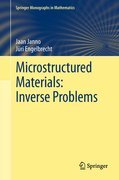
Complex, microstructured materials are widely used in industry and technologyand include alloys, ceramics and composites. Focusing on non-destructive evaluation (NDE), this book explores in detail the mathematical modeling and inverse problems encountered when using ultrasound to investigate heterogeneous microstructured materials. The outstanding features of the text are firstly, a clear description of both linear and nonlinear mathematical models derived for modelling the propagation of ultrasonic deformation waves, and secondly, the provision of solutions to the corresponding inverse problems that determine the physical parameters of the models. The data are related to nonlinearities at both a macro- and micro- level, as well as to dispersion. . The authors’ goal has been to construct algorithms that allow us to determine the parameters within which we are required to characterize microstructure. To achieve this, the authors not only use conventional harmonic waves, but also propose a novel methodology based on using solitary waves in NDE. The book analyzes the uniqueness and stability of the solutions, in addition to providing numerical examples. Mathematical modelling is based on physical principles. Physical models are interwoven with inverse problems. A novel concept of using solitary waves for NDE is proposed. INDICE: Introduction. 1 Inverse problems and non-destructive evaluation. 2Mathematical models of microstructured solids. 3 Linear waves. 4 Inverse problems for linear waves. 5 Solitary waves in nonlinear models. 6 Inverse problems for solitary waves. 7 Summary. References. Index.
- ISBN: 978-3-642-21583-4
- Editorial: Springer Berlin Heidelberg
- Encuadernacion: Cartoné
- Páginas: 160
- Fecha Publicación: 28/08/2011
- Nº Volúmenes: 1
- Idioma: Inglés
